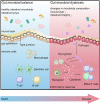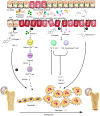Gut Microbiota and Bone Diseases: A Growing Partnership
- PMID: 35602023
- PMCID: PMC9121014
- DOI: 10.3389/fmicb.2022.877776
Gut Microbiota and Bone Diseases: A Growing Partnership
Abstract
Gut microbiota is key to human health and disease. Convincing studies have demonstrated that dysbiosis in the commensal gut microbiota is associated with intestinal and extra-intestinal diseases. Recent explorations have significantly contributed to the understanding of the relationship between gut microbiota and bone diseases (osteoporosis, osteoarthritis, rheumatoid arthritis, and bone cancer). Gut microbiota and its metabolites may become associated with the development and progression of bone disorders owing to their critical role in nutrient absorption, immunomodulation, and the gut-brain-bone axis (regulation hormones). In this work, we review the recent developments addressing the effect of gut microbiota modulation on skeletal diseases and explore a feasible preventive approach and therapy for bone diseases.
Keywords: bone diseases; bone tumor; gut microbiota; osteoarthritis; osteoporosis; rheumatoid arthritis.
Copyright © 2022 Chen, Wang, Zhang, Liu, Li and Ren.
Conflict of interest statement
The authors declare that the research was conducted in the absence of any commercial or financial relationships that could be construed as a potential conflict of interest.
Figures



Similar articles
-
Interactions between Gut Microbiota and Immunomodulatory Cells in Rheumatoid Arthritis.Mediators Inflamm. 2020 Sep 9;2020:1430605. doi: 10.1155/2020/1430605. eCollection 2020. Mediators Inflamm. 2020. PMID: 32963490 Free PMC article. Review.
-
New Advances in Improving Bone Health Based on Specific Gut Microbiota.Front Cell Infect Microbiol. 2022 Jul 4;12:821429. doi: 10.3389/fcimb.2022.821429. eCollection 2022. Front Cell Infect Microbiol. 2022. PMID: 35860378 Free PMC article. Review.
-
Gut-bone axis perturbation: Mechanisms and interventions via gut microbiota as a primary driver of osteoporosis.J Orthop Translat. 2025 Jan 21;50:373-387. doi: 10.1016/j.jot.2024.11.003. eCollection 2025 Jan. J Orthop Translat. 2025. PMID: 40171106 Free PMC article. Review.
-
Targeting the gut microbiota-related metabolites for osteoporosis: The inextricable connection of gut-bone axis.Ageing Res Rev. 2024 Feb;94:102196. doi: 10.1016/j.arr.2024.102196. Epub 2024 Jan 12. Ageing Res Rev. 2024. PMID: 38218463 Review.
-
Prebiotic effects: metabolic and health benefits.Br J Nutr. 2010 Aug;104 Suppl 2:S1-63. doi: 10.1017/S0007114510003363. Br J Nutr. 2010. PMID: 20920376 Review.
Cited by
-
Microbiota of the gastrointestinal tract: Friend or foe?World J Gastroenterol. 2023 Jan 7;29(1):19-42. doi: 10.3748/wjg.v29.i1.19. World J Gastroenterol. 2023. PMID: 36683718 Free PMC article. Review.
-
Nanobiotechnology Unveils the Power of Probiotics: A Comprehensive Review on the Synergistic Role of Probiotics and Advanced Nanotechnology in Enhancing Geriatric Health.Cureus. 2025 Mar 12;17(3):e80478. doi: 10.7759/cureus.80478. eCollection 2025 Mar. Cureus. 2025. PMID: 40225478 Free PMC article. Review.
-
Gut microbiota and osteoarthritis: epidemiology, mechanistic analysis, and new horizons for pharmacological interventions.Front Cell Infect Microbiol. 2025 Jul 16;15:1605860. doi: 10.3389/fcimb.2025.1605860. eCollection 2025. Front Cell Infect Microbiol. 2025. PMID: 40740348 Free PMC article. Review.
-
The causal relationship between gut microbiota and bone mineral density: a Mendelian randomization study.Front Microbiol. 2023 Oct 23;14:1268935. doi: 10.3389/fmicb.2023.1268935. eCollection 2023. Front Microbiol. 2023. PMID: 37937216 Free PMC article.
-
Characterization of the gut microbiota and fecal metabolome in the osteosarcoma mouse model.Aging (Albany NY). 2024 Jul 3;16(13):10841-10859. doi: 10.18632/aging.205951. Epub 2024 Jul 3. Aging (Albany NY). 2024. PMID: 38967635 Free PMC article.
References
Publication types
LinkOut - more resources
Full Text Sources

